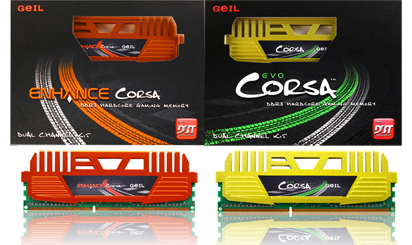
We tried: GeIL EVO Veloce and EVO Leggera
We have had memories for quite some time and what God is doing, we were able to try GeIL products last time. Perhaps the reason for the rare hospitality may be that development in this market is less rapid and manufacturers also have less room for maneuver than, for example, in the case of video cards.
The name of GeIL does not need to be presented, it has already honored quite a few of their RAMs, now with the help of Bluechip, two GeIL products have arrived again, representing the new EVO family, EVO Leggera and EVO Veloce.


Before we introduce them, we can’t miss our indispensable advice on buying memory from our memory articles - we need to set up an approximate sequence of how to buy memory:
- To specify the type of memory to purchase: This is done by the memory controller in our system and the motherboard determine, the former can be integrated into the processor or in a chipset. Some motherboards can be considered hybrid and support two types of memory, but this is not very common. So the easiest way to find out what kind of modules to buy is from the box or manual of your motherboard. Nowadays, this is DDR2 or DDR3, and in the case of expansion or failure of older machines, DDR1 is rarely sought after.
- To determine the amount of memory required: You may want to think about what you want to use your computer for. If you just net, film, play less resource-intensive games, 2GB is still enough. We would not recommend 1 GB with a good heart, as it can easily become a limiting factor in terms of system performance and smoothness. With 2GB of RAM, you don’t need to use a 64-bit operating system, you can safely stay on 32-bit. If you want to run more serious games, unfortunately 2GB is often a small 3 or 4 GB package, depending on whether it is a 3 or 2 channel KIT. In this case, however, the use of a 64-bit operating system is already justified. 4GB is pretty much enough at the moment, but if you really play at the roughest quality levels, very high resolution, maybe encode video, edit images, the programs won’t get angry at the sight of 6 or maybe 8 GB of RAM. However, this is really the ceiling, buying more memory than this is very difficult to justify, possibly because we don’t know where to put our money. If we had to suggest, we would consider 4GB in a two-channel package ideal for buying a new machine.
- Select memory speed: We have to decide how much fast memory is needed for our purposes, since the faster a module costs, the more it costs, so it is not advisable to waste money unnecessarily. On the net, home theater should not be exaggerated, the pace of RAM is less important. For games or resource-intensive applications, on the other hand, extra speed can be useful, which is determined by the operating frequency and delay values of the module. It makes sense that the former should be as high as possible and the latter as low as possible, but we will certainly be forced to compromise in some areas. Which feature programs like better varies from case to case. From DDR2 today, the 800/1060/1200 MHz modules are dominant, while from DDR3, starting at 1333 MHz, crossing 1600 MHz, the border is all the way to the starry sky, somewhere below 3 GHz, but at 2 GHz. or kits above are already considered a premium product. When buying DDR2, we would prefer the 1066 package, as it may have the best price / performance ratio, 800 MHz may be low, but 1200 MHz products are disproportionately expensive. On the DDR3 line, perhaps 1600 MHz seems to be the area to be targeted.
- Importance of memory manufacturer / brand: As with everything, it is also true for RAMs that it is not necessarily the cheapest that is worth buying, because as they say, the juice of cheap meat is thin — of course, if a memory also has juice, it is already bad. It is true that, with careful selection or with great luck, you can find a treasure among the "noname" pieces, but if possible, choose from the more famous and well-known products. Some manufacturers stay at the entry level only with the price in mind, but most companies try to cover the entire range, from the simplest needs to aggressive tuners.















